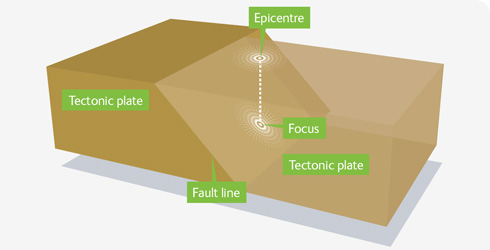What causes an earthquake?
When you click your fingers, friction between your fingertips allows you to increase the pressure until it is released suddenly.
In a similar way, friction between rocks near Earth’s surface allows pressure to build up slowly over time. When the pressure becomes too great, the slabs of rock jump or snap, releasing a massive pulse of energy through the surrounding rock, known as a seismic wave.
The rocks vibrate back and forth for a while before coming to a stop. Each back and forth is the shaking we feel as an earthquake.
The huge forces that produce earthquakes are due to the movement of tectonic plates – huge pieces of Earth’s outer shell that are slowly moving up to a few centimetres a year.
Find out more about plate tectonics
Earthquake glossary
- Focus: the point where an earthquake starts underground. The closer the focus is to the surface, the stronger the earthquake will feel.
- Epicentre: the point on the surface directly above the focus.
- Fault/fault line: breaks in the ground caused by the movement of plates.
- Tectonic plate: Earth’s crust is split into a number of plates. These plates can pull apart (divergent plate boundary), push into each other (convergent plate boundary) or rub past one another (transform plate boundary). Wherever this happens, faults can open up.
